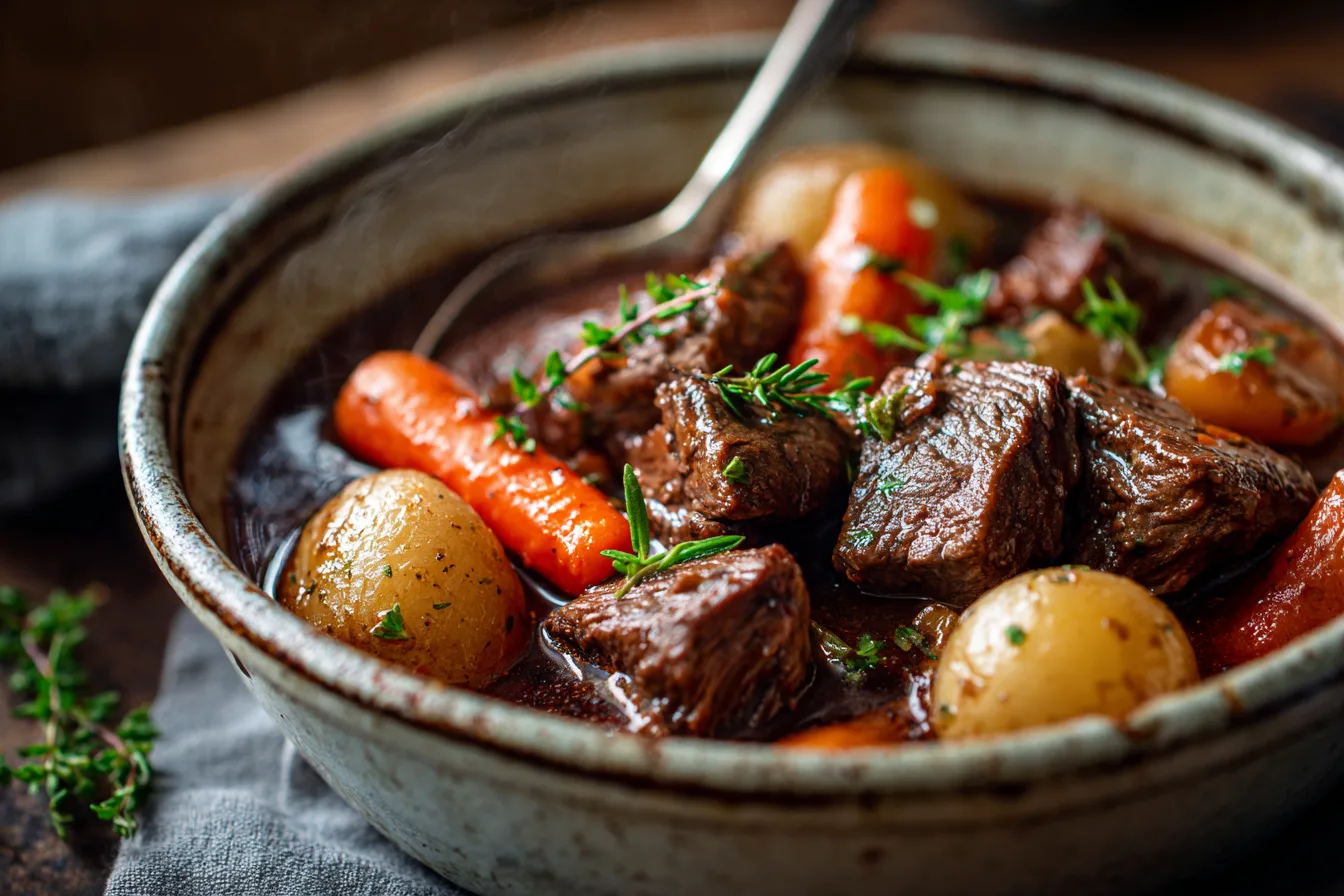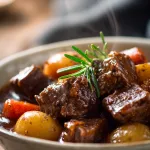Slow Cooker Beef Stew with Red Wine That Tastes Like Time
There’s a smell you don’t forget. Beef, wine, onions. It’s the kind of smell that makes the dog lift his head, the kids wander into the kitchen, the house go quiet for a second.
That’s beef stew done right.
I learned it the hard way. Twenty years of kitchens from Los Gatos to Santa Cruz, fancy dining rooms to late-night catering gigs, and I’ve burned, rushed, and over-reduced more pots of stew than I’ll admit. Somewhere along the way, I realized the best version doesn’t happen on the stove at all. It happens in a slow cooker, given time and a little patience.
When I started cooking professionally, I thought patience was for people without tickets printing. But stew taught me different. You can’t rush tough meat into tenderness. You coax it.
New to long, gentle cooking? Start with the fundamentals of what braising really is so your first slow cooker stew lands rich, not watery.
Why Red Wine Changes Everything
If you’ve ever had a stew that tastes flat, like boiled meat and sadness, it’s because no one gave it acid.
That’s what red wine does – it brings life back into all that brown.
A friend of mine, a winemaker up near Watsonville, once handed me a leftover jug of Merlot after a farm event. I poured it into a pan with browned beef bits still clinging to the bottom, and suddenly it smelled like France and home all at once.
Pinot Noir makes the sauce soft and round, Cabernet gives it bite, and cheap cooking wine ruins it. I tell everyone the same thing — cook with wine you’d actually drink. You don’t need to spend much, but it should taste like something.
To understand why that splash of Merlot wakes the pot up after searing, review how to deglaze a pan and pull every browned bit into the sauce.
The Meat Matters More Than the Recipe

Every time I walk through the market in Santa Cruz, I see someone grabbing a plastic tray marked “stew meat.” Don’t. It’s the junk drawer of cuts, whatever was lying around. Sometimes chuck, sometimes round, sometimes who knows what.
Ask for a chuck roast instead.
Heavy. Marbled. The kind that looks like it could break your cutting board.
That’s what you want. The shoulder. Tough as leather when raw, buttery after eight hours on low.
I used to prep fifty pounds of it for resort banquets. I’d stand over the tilt skillet, searing in batches, that smell of caramelized beef filling the kitchen. The line cooks would wander by pretending they needed something, just to snag a bite.
That’s how you know it’s right, when the raw crew starts pretending they’re hungry.
Pick the right cut with confidence by scanning decoding meat cuts, you’ll see why chuck wins for slow, moist heat.
Anchovy Paste Is The Little Trick That Fixes Everything
Now, this next part I’ll get side-eyed for, but I’m telling you – one teaspoon of anchovy paste makes the whole thing sing.
Not fishy. Not weird. Just deeper.
It’s what restaurants do when they want to charge thirty bucks for a bowl of stew.
You stir it into the tomato paste and garlic, let it melt into the fat, and you’ll never go back.
Back when I was running a small catering team, I forgot the anchovy one night. We served a hundred bowls and folks said it was fine. Then the next week I added it back in, same recipe otherwise. Everyone asked what changed.
That’s how subtle it is. No one tastes it, but everyone feels it.
If the word “umami” feels abstract, this quick primer on culinary terms puts names to the flavors you’re tasting in the finished stew.
The Slow Cooker Routine

Here’s how a day looks when I make this at home.
Morning light hits the kitchen counter, fog still hanging low over the bay. I cube the beef, sprinkle salt and pepper, toss it with flour. The skillet goes down, olive oil just starting to shimmer. You hear the first hiss when the meat hits metal. That’s when I know I’m doing something right.
You brown in batches. Always.
If you crowd the pan, it steams and turns grey. Nobody wants grey meat in their stew.
Once the beef is browned, I pull it out and use that same pan for the onions, garlic, tomato paste, and that tiny bit of anchovy paste. I cook until the paste darkens, smells nutty. Then I pour in the wine.

This is my favorite part.
The kitchen fills with that rush of steam, sweet and sharp, wine hissing against hot steel. You scrape up the browned bits with a wooden spoon, let it bubble down a few minutes, then pour it all over the beef waiting in the slow cooker.
Add broth, carrots, potatoes, mushrooms if you’ve got them, a bay leaf, a few sprigs of thyme and rosemary. Lid on. Low for eight hours.

And then… nothing.
You walk away.
That’s the beauty of it.
Set yourself up for hands-off success by skimming how to read a recipe – you’ll spot timing cues and “hands off” moments before you start.
What It Should Smell Like
Around hour six, it starts to change.
The wine smell softens, turns into something round and savory. The beef goes from stringy to falling apart. You’ll notice the sauce looks thin for most of the cook, don’t panic.
It thickens near the end when the flour and starch from the potatoes kick in.
When I open the lid, I look for one thing: does it smell like home? If it still smells mostly of wine, it needs longer. If it smells like beef and comfort, you’re there.
How I Serve It

For family dinners, I keep it rustic, ladled into bowls with a piece of crusty bread.
At catering events, we plate it over garlic mashed potatoes or creamy polenta. I’ve even served it in tiny ramekins with puff pastry lids for fancy hors d’oeuvres gigs in Los Gatos. Same stew, just dressed up.
And at home? Sometimes I eat it straight from the slow cooker with a spoon while it’s still too hot. Occupational hazard.
Want hot bread on the table without fuss? These quick dinner rolls bake while the stew rests and soak up every drop.
The Leftover Secret
Stew gets better overnight. That’s not a saying; that’s science.
The collagen keeps breaking down, the flavors marry.
When I was younger, we’d stash the hotel pans in the walk-in after service, then sneak in the next morning and eat cold stew for breakfast. Better than any hangover cure.
At home, I let it cool, then store in glass containers. Reheat gently with a splash of broth. Never microwave on high — it tightens the beef. Gentle heat only.
It also freezes fine. I portion it, label it, and forget about it until some rainy Thursday night. Then it’s dinner again, no effort.
For a crisp cut of acidity next to that wine-rich bowl, toss the shaved fennel and apple salad—bright, fast, and sturdy.
What Not to Do
Don’t skip the sear. That’s rule number one.
Don’t use sweet wine — you’ll regret it.
And don’t overthink it. People fuss about exact times and measurements. It’s stew, not soufflé.
You’re looking for feel: meat tender, vegetables soft but holding shape, sauce thick enough to coat a spoon.
A Word on Vegetables
Carrots, potatoes, peas… that’s the backbone.
But if you want to make it coastal, add mushrooms from the market.
I grab creminis or king oysters when they’re around.
You can throw in parsnips or turnips if you want it sharper, but remember they’ll change the whole character.
Once, I swapped carrots for roasted beets at a farm dinner. Gorgeous color, tasted like dirt and regret. Stick with carrots.
Cooking for a Crowd vs. Cooking for Home
When I’m feeding six, the slow cooker is perfect.
But when I was running banquets, we scaled this up for a hundred. We browned the meat in the tilt skillet, made a vat of wine reduction, ladled everything into eight pots on low side by side.
The line looked like a science experiment, steam cloud thick as fog over the bay.
The funny thing? The small batch at home always tastes better. Probably because I’m not yelling over a Hobart mixer or worrying about plating times.
Scaling up for a party? Read volume vs. weight in cooking to keep large-batch seasoning accurate.
Nutrition and Reality
Everyone asks if it’s healthy. Depends how you define that. It’s vegetables, yes. It’s protein. But it’s also red wine, olive oil, and beef fat doing their thing.
You don’t eat this when you’re chasing numbers. You eat it because you’ve worked all week, you’re cold, and you need something honest in a bowl.
Ingredient Swaps I’ve Actually Tried
Skip the wine? You can. Use extra beef broth and a splash of balsamic. But it won’t be the same.
Use chicken broth? Sure, if that’s what you’ve got. It’ll taste lighter, less rich.
No anchovy paste? Add soy sauce, a dash of fish sauce, or Worcestershire, but honestly, just buy a tube of anchovy paste. It lasts forever.
I’ve tried swapping beef for lamb. Works, but it becomes a different stew altogether — gamier, heavier. Stick with chuck for the real thing.
If you’re tracking portions for hearty dishes like this, the recipe yield explainer helps you plan servings without guesswork.
Coastal Notes
Santa Cruz and the surrounding farms make cooking easy. The carrots come with dirt still clinging. The onions feel heavy and smell alive. The red wine comes from just up the road.
There’s something special about cooking local food that ends up tasting like your neighborhood.
I swear the salt in the air from the bay changes things, maybe that’s just nostalgia, but I’ll take it.
When I’m at the market, I buy by touch. Carrots with snap, potatoes with weight, garlic with tight skin. No fancy talk, just instinct.
Slow Cooker Beef Stew with Red Wine Recipe
Print
Slow Cooker Beef Stew with Red Wine
Description
This slow cooker beef stew with red wine is built for cold nights when you want something that tastes like it cooked all day, because it did. Tender chunks of beef simmer with carrots, potatoes, and herbs in a rich sauce of red wine and broth that thickens naturally as it cooks. The small twist that makes this version stand out is a spoonful of anchovy paste stirred in during browning. It melts into the sauce and deepens the savory flavor without tasting fishy. It’s the secret chefs use to give stews that restaurant-level richness.
Equipment:
- 6-quart slow cooker
- Large skillet or sauté pan
- Tongs
- Wooden spoon or spatula
- Ladle
- Small bowl for slurry
Ingredients
- 2 1/2 pounds beef chuck roast, trimmed and cut into 1 1/2-inch cubes
- 1 teaspoon kosher salt (plus more to taste)
- 1/2 teaspoon black pepper
- 2 tablespoons all-purpose flour
- 2 tablespoons olive oil
- 1 tablespoon tomato paste
- 1 teaspoon anchovy paste (optional but highly recommended)
- 4 cloves garlic, minced
- 1 large yellow onion, diced
- 1 1/2 cups dry red wine (Cabernet Sauvignon or Pinot Noir work best)
- 3 cups low-sodium beef broth
- 1 tablespoon Worcestershire sauce
- 1 teaspoon balsamic vinegar
- 1 teaspoon dried thyme (or 3 sprigs fresh thyme)
- 1 teaspoon dried rosemary
- 1 bay leaf
- 4 large carrots, peeled and sliced into thick rounds
- 1 1/2 pounds baby potatoes, halved
- 1 cup sliced mushrooms (optional but adds earthiness)
- 1 cup frozen peas (added at the end)
- 1 tablespoon cornstarch mixed with 1 tablespoon cold water (for thickening, optional)
Instructions
- Pat the beef cubes dry with paper towels. Season with salt and pepper, then sprinkle with flour and toss to coat evenly.
- Heat olive oil in a large skillet over medium-high heat. Brown the beef in batches so the pieces have space to sear. Don’t rush this—it’s where the flavor builds. Transfer browned beef to the slow cooker.
- Lower the heat to medium. In the same pan, add tomato paste and anchovy paste. Stir until the paste darkens slightly and smells rich, about 1 minute. Add garlic and onion and cook 2–3 minutes, scraping up any browned bits from the pan.
- Pour in the red wine to deglaze the pan. Scrape the bottom again with a wooden spoon to release the flavorful bits. Let the wine simmer 2–3 minutes to reduce slightly.
- Pour the wine mixture over the beef in the slow cooker. Add beef broth, Worcestershire, balsamic vinegar, thyme, rosemary, bay leaf, carrots, potatoes, and mushrooms if using. Stir gently to combine.
- Cover and cook on LOW for 8 hours or on HIGH for about 4½ hours, until the beef is tender and the vegetables are soft.
- In the last 15 minutes of cooking, add the peas and stir in the cornstarch slurry if you want a thicker stew. Let it simmer until slightly thickened.
- Taste and adjust seasoning with more salt, pepper, or a splash of balsamic vinegar if it needs brightness. Remove the bay leaf before serving.
Notes
The anchovy paste is the quiet hero of this stew. It doesn’t make it taste like fish—think of it as pure umami. It replaces the need for extra salt or bouillon and rounds out the sauce. If you skip it, the stew will still be good, but with it, it tastes like you spent hours layering flavors.
For wine, pick one you’d actually drink. Pinot Noir gives a lighter, fruity note; Cabernet Sauvignon or Merlot gives a deep, bold sauce.
You can prep everything the night before. Keep it covered in the fridge, then plug it in the next morning.
It freezes beautifully for up to 3 months. Reheat slowly on the stove or microwave, adding a splash of broth to loosen the sauce.
Nutrition
- Serving Size: 1 Serving
- Calories: 475 kcal
- Sugar: 5g
- Sodium: 710mg
- Fat: 21g
- Saturated Fat: 6g
- Carbohydrates: 25g
- Fiber: 3g
- Protein: 38g
Common Questions from Friends and Students
You can. But it won’t taste the same. Use broth and balsamic if you must.
You can crank the slow cooker to high for 4 ½ hours, but low and slow is the move. It’s in the name.
Yep. It holds up for three months easy. Thaw overnight, reheat gently.
Chuck. Always chuck. Don’t argue with me.
Coats the spoon, doesn’t drown the bread.
At the end, always. Last 15 minutes, or they turn grey and sad.
Whatever’s crusty. I like a sourdough boule from Companion Bakeshop in Santa Cruz — still warm, crackly crust.
The Chef’s Finish
There’s a moment right before serving when you lift the lid and the stew looks like a small storm, bubbles rising, herbs floating, beef dark and soft. I take a taste straight from the ladle. That’s how you know it’s done. Not the timer. The taste.
I’ve cooked this stew in a kitchen feeding two hundred and in a cabin for four.
Both times, the smell made people stop talking for a second. That’s the goal. Food that makes the room pause.
Make it once. Watch people lean in when it hits the table.
And when everyone’s done, scrape that last spoonful for yourself.
About the Author
Ryan Yates is a culinary expert with over 20 years of experience in commercial kitchens. As a working executive chef, he has a passion for creating delicious, accessible recipes that bring joy to home cooks everywhere. Ryan believes in the magic of simple ingredients and loves sharing his knowledge to help others find happiness in cooking.



